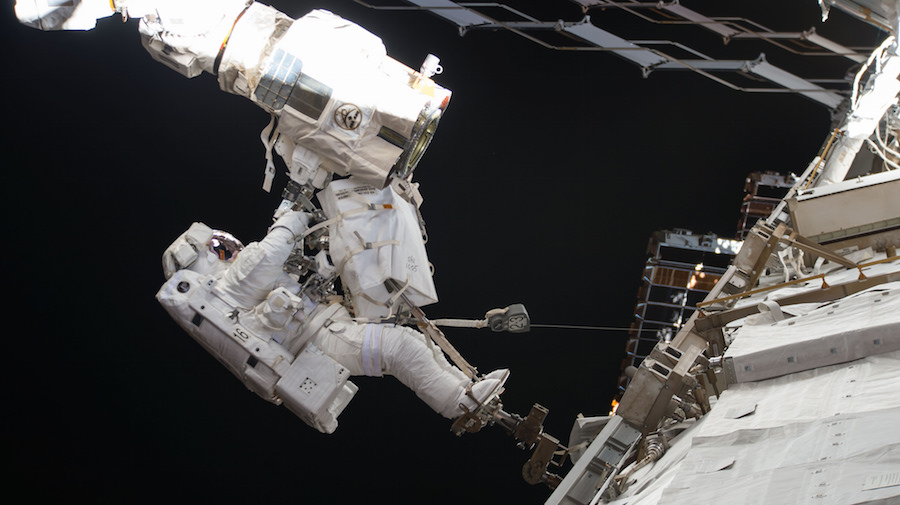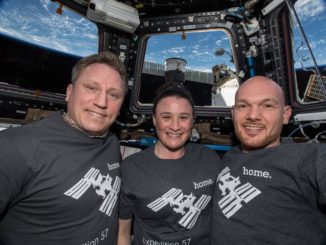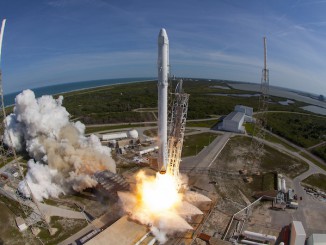EDITOR’S NOTE: Updated at 3 p.m. EST (2000 GMT) after the end of EVA.
STORY WRITTEN FOR CBS NEWS & USED WITH PERMISSION

Two astronauts floated outside the International Space Station early Tuesday and replaced one of the grapple fixtures on the end of the lab’s robot arm, the first of two excursions over the next week to complete a complex overhaul that began with a pair of spacewalks last October.
Floating in the station’s Quest airlock, astronaut Mark Vande Hei and crewmate Scott Tingle switched their spacesuits to battery power at 6:49 a.m. EST (GMT-5) to officially kick off the 206th spacewalk since station assembly began in 1998.
“Make us proud out there, we’ll have hot chow when you get back,” astronaut Joe Acaba radioed from inside the station.
The goal of the spacewalk was to complete repairs on the station’s Canadarm 2 space crane, a 50-foot-long robot arm that can move end over end, inchworm fashion, from one mounting fixture to another to reach various work sites along the station’s main power truss.
Each end of the arm is equipped with a complex grapple fixture, known as a latching end effector, or LEE, that uses motorized snares to lock onto anchor fittings and plug into power, data and video connectors. Arm anchor points are mounted on station modules and on a mobile base rail car that can carry the arm to work sites along the truss.
With one latching end effector locked onto station structure or the mobile base, the LEE on the far end can be used to move astronauts, station components and even visiting cargo ships from point to point.
The arm was launched to the station aboard a space shuttle in 2001. Several years ago, engineers noticed signs of wear and tear in the LEE mechanisms and NASA managers eventually decided to replace both units.
Last October, astronauts replaced one aging grapple mechanism — LEE-A — and during Tuesday’s outing, Vande Hei and Tingle replaced LEE-B with a spare that was launched in 2009.
The replacement work went smoothly but took a bit longer than expected. In an initial test, the arm’s software was unable to communicate with the newly installed LEE-B mechanism.
“Big picture wise, what’s going on with the arm, this software download issue is preventing us from talking to the LEE like we want to,” astronaut Victor Glover radioed from mission control in Houston. “So we’re … powering down the arm and marching toward re-doing a connector cycle. We’re not physically going to remove the LEE again, we’re just going to cycle that mate-demate mechanism.”
Vande Hei and Tingle disengaged and then reset the mate-demate fitting and the arm powered back up normally. After that, the spacewalkers cleaned up the worksite, returned to the airlock and began repressurization at 2:13 p.m., ending a seven-hour 24-minute excursion.
The LEE mechanisms are critical to robot arm operations. Each one is roughly cylindrical, about three fee long and weighs, on Earth, about 450 pounds.
“This is a complex mechanical package,” said Tim Braithwaite, a Canadian Space Agency liaison officer at NASA. “This does all the hard work of grasping physical interfaces as the arm is reaching out, whether the arm is walking end-over-end around the space station or picking up DEXTRE, our two-armed robot, to do space station maintenance or catching free-flying cargo vehicles. This is where all of that work is taking place.”
Vande Hei and Tingle first set up the spare LEE for removal from External Stowage Platform No. 2 and then Japanese astronaut Norishige Kanai, working at a control panel inside the station, moved the LEE-B end of the arm down to the spacewalkers. The degraded LEE-B mechanism was disconnected from the arm and temporarily stowed. The spare unit then was installed.
During a spacewalk next Monday, Vande Hei and Japanese astronaut Norishige Kanai will conduct a second spacewalk to mount the degraded LEE-B mechanism on a spare anchor fitting on the mobile base rail car. If all goes well, it will remain there for the life of the space station, used sparingly to hold components in place as required.
The LEE-A mechanism that was removed last October and initially mounted on the mobile base system will be brought inside the space station. It will eventually be returned to Earth aboard a SpaceX Dragon cargo ship, refurbished and re-launched. Another spare LEE currently is awaiting launch.
“About three years ago, we started monitoring normal wear and tear in the arm,” said Braithwaite. “This was in the end effector mechanism specifically, and this manifested as increasing motor currents going to those mechanisms.”
Engineers monitored the performance and spacewalking astronauts lubricated the internal snare mechanisms to reduce friction.
“That was done in two separate spacewalks back in 2015,” Braithwaite said. “We saw a real improvement in the LEE performance after that and that bought us a couple of years. But then last year, we started more intensive planning, knowing we were going to replace both LEEs. The first (replacement) we did last October.”
With the completion of Tuesday’s spacewalk, “Canadarm 2 will have fresh hands and be ready to get about the business of the rest of the program,” Braithwaite said. “Worth noting, these original Canadarm 2 LEEs both comfortably exceeded their design expectation, lasted years longer than we thought they were going to. So we’re really pleased with that.”
Tuesday’s spacewalk was the 206th devoted to station assembly and maintenance since 1998, the first of up to 12 U.S. and Russian EVAs planned for 2018, the third for Vande Hei and the first for Tingle. Total station spacewalk time now stands at 1,285 hours and 49 minutes, or 53.6 days.



